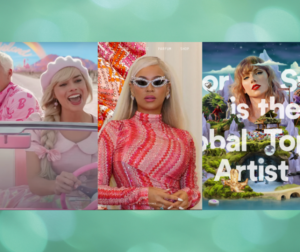Barbie, Beyonce, Taylor Swift & 2023: The Year Women Drove the Economy
Does your company recognize the power of women in the marketplace?
In 2023 the collective spending power and the influence of women in the marketplace FINALLY made headlines – and women were given credit for driving the economy.
Let’s be candid, three women led the way and put up some impressive data points while breaking records:
“Barbie” surpassed $1 billion in global ticket sales and made history as Warner Bros.’ highest-grossing film of all time. Greta Gerwig, who both wrote and directed the movie, had the biggest-ever debut weekend for a female director and became the first woman to have sole directing credit on a billion-dollar film. The movie promotion was awash in themed marketing campaigns, cross-promotions, and pink carpets in the theaters for movie viewers who dressed up for the event.
Beyonce’s Renaissance World Tour “pulled in $579 million, making it the second highest-grossing tour by a female artist in history, and the seventh-highest-grossing tour overall,” according to Entertainment Weekly. That’s 2.78 million tickets for 56 shows in 39 cities in North America and Europe. Her concerts created spikes for local economies in the tour cities with fans purchasing hotel rooms, meals and transportation along with increased business for nail and hair salons – and sent prices soaring. Additionally, US ticket sales for the movie version of the tour earned more than $21 million on opening weekend and $44.4 million to date.
Taylor Swift’s Eras Tour broke records (and ticketing systems) across the board. Her tour has earned $1.4 billion to date for her ongoing worldwide tour of 151 cities, which began in March 2023 and is scheduled to conclude in December 2024, making it the highest-grossing music tour to date and the first to reach the $1 billion mark after 60 shows in 2023. Attendees spent $4.6 billion on tickets, concert merchandise, hotel rooms and clothing to wear to the show along with craft supplies for friendship bracelets to give away. As Time magazine noted, her concert in Glendale, Arizona brought in more revenue for local businesses than the Super Bowl, held at the same venue earlier in the year (2023). The release of the movie version of the tour has grossed $261.6 million worldwide making it the highest-grossing concert film.
KUDOS! Individually and collectively, these women generated more revenue than many countries produced in a year.
But let’s be honest, women driving the economy isn’t new news! What’s new is numbers that are too big to ignore and multiple record-breaking accomplishments. In my book, “Why Women: The Leadership Imperative to Advancing Women and Engaging Men,” I wrote about the “$20 Trillion Niche” and the enormity of the global buying power of women.
“Women in the US buy or influence more than 80% of all car purchases yet most automakers, dealers and salesmen treat them like a niche.” – Jeffery Tobias Halter
Does your company recognize the power of women in the marketplace and in the workplace?
Consider this data from Morgan Stanley:
- Women contribute an estimated $47 trillion to the US gross domestic product – Center for American Progress.
- They are the principal shoppers in 72% of households – MRI-Simmons.
- Women control purchase decisions and budgets and are largely responsible for choosing which products and brands to buy.
- Women are the primary breadwinners for 30% of married households and nearly 40% of total US households.
- Historically, women in the US buy 65% of all new cars, 45% of all light trucks and SUVs and influence 80% of all car purchases.
- 75% of women feel misunderstood by car marketers.
- 95% of the country’s 20,000 auto dealers are owned and operated by men.
The Next Killer App for greater revenue growth and improving operating profit is not a technology. It’s about unleashing the Power of Women in your organization. To survive and prosper, it’s incumbent on leaders to move their organization to a deeply internalized approach regarding gender differences, executed with a sense of urgency, to create competitive advantage.
Bridget Brennan writes that “culture plays an enormous role in consumer behavior, but it can be hard to ‘see’ culture when we are living in the midst of it.” She suggests using these as guides to avoid stereotypes and stay culturally relevant with women consumers today:
- Update your idea of what a “breadwinner” looks like and make it more inclusive of women.
- Recognize that women dominate higher education and are fast becoming the majority of the college-educated workforce.
- Consider that the face of wealth is increasingly female.
As you ponder these questions, here are my quick takeaways:
As a senior leader of your organization, you must constantly think and pose these questions to your corporate marketing department and implement measures and metrics as part of your strategy for delivering business results for women.
- Don’t homogenize women: This is a no-brainer. Every woman is unique and multidimensional, and it is unwise to have a one-size-fits-all approach to marketing and selling to women.
- Millennial women are not their moms: Millennial women are nothing like their mothers. They buy different things and place a greater cache on uniqueness and individuality and the impact their buying has on the society and environment at large. Case in point: think of their locally sourced, cage-free, hand-raised egg-buying behavior.
- Gen Z are not Millennial Women: Each generation of women has unique buyer behavior. Gen Z women do not purchase, use or prefer products the way Millennial women do.
- The future (present) is multicultural: We know America is set to be a minority-majority nation by 2043 where the population is going to be majority non-white. Given this reality, what is your organization doing to market to an audience where the non-white woman is eager and willing to try and buy your product or service?
- Educate the men in your organization: Men still represent 80% of leadership in most companies, which means they are 80% of the problem and 80% of the solution. The visible and vocal commitment of the men in your organization is critical to driving change.
Additionally, to drive long-term systemic change for women in your organizations I advise senior male leaders to Listen, Learn, Lead and Have the Will to Change. One of the first steps I advocate is to actively listen — without inserting comments or judgments — to their female colleagues. It can be eye-opening to find a female “cultural coach,” who is someone you can have an honest discussion with regarding the real experiences women are having in your company and industry. You will find that men and women have significantly different experiences in the workplace — and in the marketplace.
When we consider how women are driving the economy, the bottom line is this: You can either choose to engage in this conversation or realize you will soon become the next Sears or Circuit City. The choice is yours.
Related article: Why Every Ally Needs to See “Barbie”

